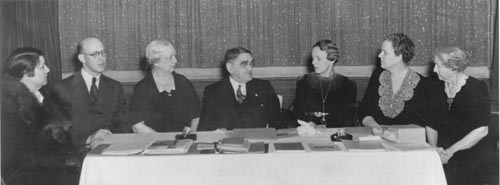12 Dec. 1867–11 Oct. 1962
Emily Gregory Gilliam Gary, moving force behind the development and preservation of historic buildings and sites in colonial Halifax, N.C., was the daughter of George and Marie Antoinette Mullen Gilliam and a

native of Hertford, Perquimans County. "Miss Emily," as she was affectionately known in her later years, moved to Halifax when she was five. A school teacher for nineteen years, she was active in the work of St. Mark's Episcopal Church in Halifax, the Halifax Home Demonstration Club, the United Daughters of the Confederacy, the Halifax Garden Club, and the Parent-Teacher Association. She was granted life membership in the National PTA Congress. In 1901 she married Frederick Sterling Marshall Gary, who served for forty years as clerk of the court in Halifax.
Mrs. Gary early realized that many of the historic buildings in Halifax, dating from the period when the town was one of North Carolina's cultural centers, were being sadly neglected and allowed to fall into ruin. She felt that the state and nation should devote greater emphasis to the significance of the Halifax Resolves, adopted 12 Apr. 1776, the first action by any of the colonies calling for independence from Great Britain. Tirelessly devoting her energies to the preservation of the rich history of Halifax, she sought financial aid from the Ford Foundation and the Firestone family in hopes that they would adopt Halifax as the Rockefeller Foundation had done with colonial Williamsburg in nearby Virginia. In the mid-1950s, Mrs. Gary gained the enthusiastic support of the Halifax County Board of Commissioners in purchasing the old gaol in Halifax, which at the time was scheduled to be sold and possibly demolished. Later, assisted by Mrs. R. L. Applewhite and other ladies in Halifax, she served as a volunteer hostess on Sunday afternoons at the Halifax Museum established at the gaol.
Largely through Mrs. Gary's efforts, the Halifax Historical Restoration Association was established and for many years she served as its efficient and dedicated secretary. She was also instrumental in having the old clerk of court's office building converted into the Halifax County library. Her own residence, formerly the Eagle Tavern, was eventually moved to the Halifax historic site area for restoration.
After her death at age ninety-five, Mrs. Gary was buried in the local Episcopal cemetery.